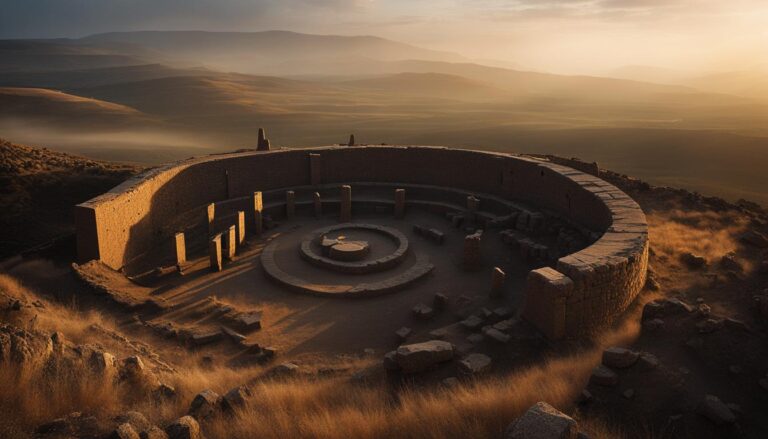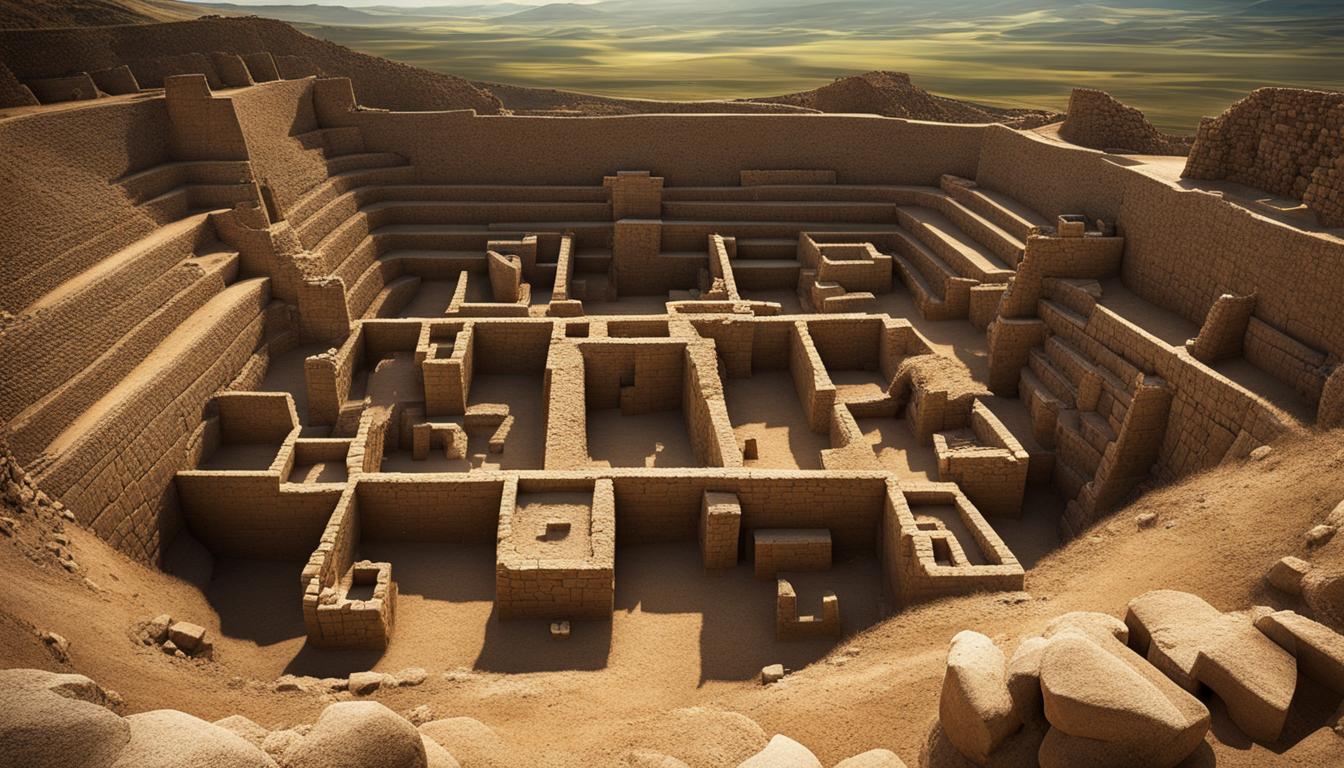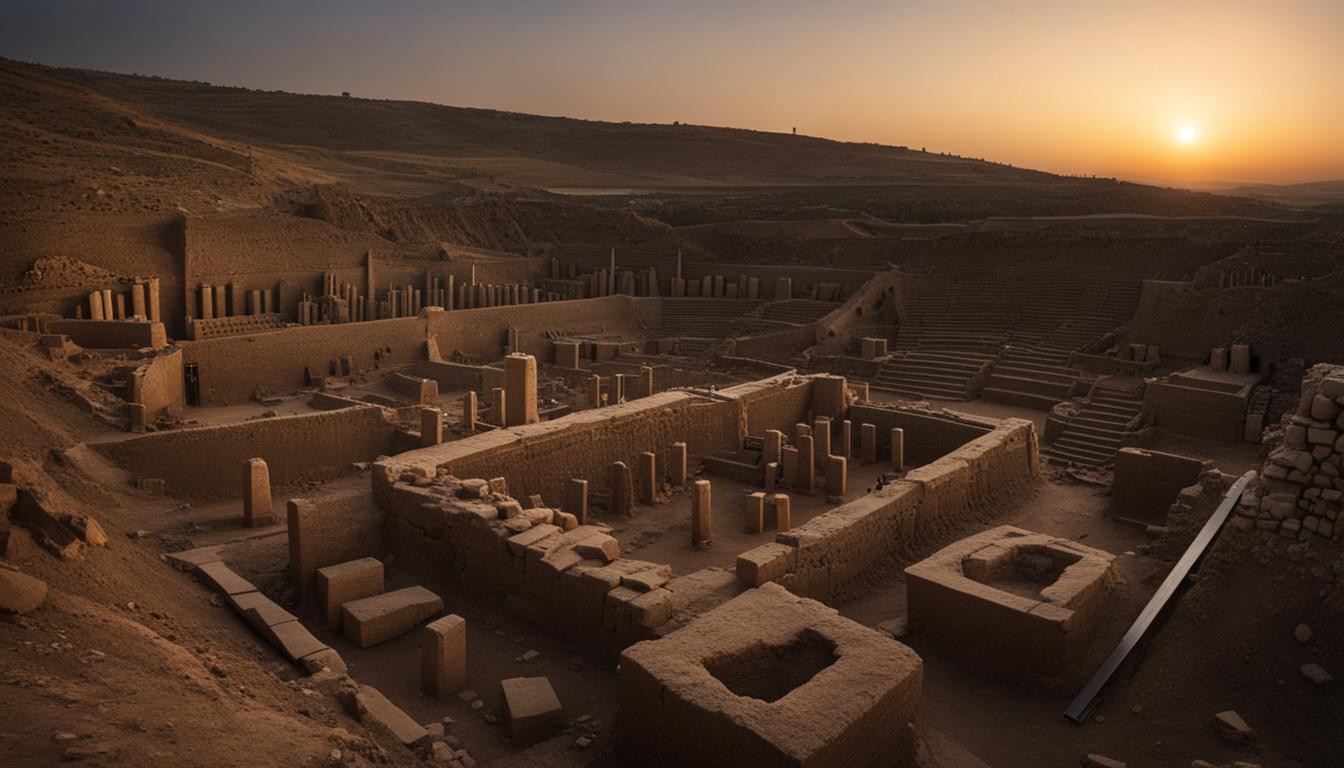Gobekli Tepe has captured the attention of archaeologists and historians alike, as it stands as evidence of a remarkable ancient civilization that thrived over 10,000 years ago. Located in southeastern Turkey, this enigmatic site raises many questions about the origins of human society and the development of civilization.
The discovery of Gobekli Tepe has challenged existing theories about the evolution of human culture, pushing back the timeline of complex societies by millennia. Its monumental structures, intricate carvings, and advanced architecture are a testament to the ingenuity of the ancient civilization that built it.
Key Takeaways:
- Gobekli Tepe is an ancient site located in southeastern Turkey.
- It challenges existing theories about the development of human civilization.
- Its structures and architecture are evidence of an advanced ancient civilization.
- Gobekli Tepe’s discovery has expanded our understanding of human history.
Exploring Gobekli Tepe’s Architectural Marvels
Gobekli Tepe is a prime example of the architectural prowess of the ancient civilization that thrived over 10,000 years ago. The site contains remarkable architectural features that are a testament to the advanced capabilities of this society.
The most striking aspect of Gobekli Tepe is undoubtedly the monumental stone pillars that are found throughout the site. These pillars are arranged in a circular pattern and are adorned with intricate carvings of animals, including lions, snakes, and birds of prey.
These carvings are not only visually stunning but also represent an impressive feat of craftsmanship. The precision and detail of the carvings suggest that the ancient civilization had a sophisticated understanding of stone carving techniques, a skill that was likely passed down through generations.
In addition to the stone pillars, the site also contains several T-shaped pillars, which are even larger and more elaborate than the other pillars. These pillars are thought to have held a special significance in the ancient civilization, although their precise meaning remains a mystery.
Overall, the architectural marvels of Gobekli Tepe provide a fascinating insight into the advanced capabilities and artistic sensibilities of the ancient civilization that created them.
Unearthing Gobekli Tepe’s Ancient Artifacts
Gobekli Tepe has yielded an array of ancient artifacts that offer a glimpse into the sophisticated culture, beliefs, and practices of the civilization that once thrived at the site over 10,000 years ago. The excavations carried out at Gobekli Tepe have uncovered an abundance of construction materials, stone tools, and numerous objects made of bone, wood, and limestone. The artifacts have been found in different layers of the site, with some dating back to the early Neolithic period.
One of the most notable discoveries at Gobekli Tepe is an impressive array of stone sculptures and carvings. The intricately carved pillars that form the backbone of the site, some of which reach up to 18 feet in height, are adorned with stunning depictions of animals, including foxes, snakes, and birds. The craftsmanship displayed in these carvings is a testament to the advanced skills of the civilization that created them.
The artifacts also reveal the religious and spiritual practices of the ancient civilization. The presence of numerous figurines and sculptures of humans and animals suggests that rituals and offerings were an important aspect of their beliefs. Additionally, the discovery of a large number of stone tools and hunting equipment indicates that hunting played a crucial role in their way of life.
One of the most intriguing artifacts uncovered at Gobekli Tepe is a carved stone pillar depicting a vulture and a scorpion. The imagery is believed to have religious significance, possibly as a symbol of death and resurrection. Scholars speculate that the civilization that built the site may have practiced a form of ancestor worship, as evidenced by the presence of skulls and bones buried near the site.
Overall, the artifacts discovered at Gobekli Tepe provide a fascinating glimpse into the lives and beliefs of an ancient civilization that existed long before the emergence of modern societies. The significance of these artifacts cannot be overstated, as they shed light on the origins of human civilization and offer valuable insights into our shared history.
Unveiling the Religious Significance of Gobekli Tepe
The discovery of Gobekli Tepe has sparked a great deal of speculation about the religious practices of the ancient civilization that created it. While some experts believe it was a place of worship, others suggest it could have served as a ceremonial or cultural center.
Regardless of its precise purpose, the religious significance of Gobekli Tepe is undeniable. Its monumental stone pillars and intricate carvings depict animals and symbols that likely held special meaning for the civilization that built it.
“Gobekli Tepe challenges conventional theories about the development of human civilization and demonstrates the incredible sophistication of our ancient ancestors,” says Dr. Klaus Schmidt, lead archaeologist on the Gobekli Tepe excavations.
One theory suggests that Gobekli Tepe’s creators may have believed in a pantheon of gods and goddesses, each associated with different animals or natural elements. The site’s carvings and sculptures support this idea, depicting a wide range of animals and mythical creatures.
Another possibility is that Gobekli Tepe was used for ancestor worship or funerary rites. Ancient civilizations often built elaborate tombs or burial chambers to honor the dead, and Gobekli Tepe’s buried structures could potentially serve this purpose.
Regardless of its specific function, the religious significance of Gobekli Tepe is a testament to the deep spiritual beliefs of our ancient ancestors. It underscores the importance of religion and spirituality in human culture, both in the past and present.
Debunking the Mystery of Gobekli Tepe’s Buried Structures
One of the most fascinating aspects of Gobekli Tepe is the deliberate burial of its structures. While the site was abandoned around 8000 BCE, the ancient civilization made a conscious effort to bury their monumental creations, leading to numerous theories about their motivations.
“It is clear that the people who built this extraordinary site went to great lengths to bury it. The question is why?”
– Klaus Schmidt, archaeologist
Some experts suggest that the civilization believed the site had served its purpose and that burying it was a way of honoring it. Others speculate that the burial was a practical measure to protect the structures from erosion or other environmental factors. There are also theories that suggest the burial was a ritualistic act, possibly linked to the civilization’s religious beliefs.
What is clear is that the buried structures of Gobekli Tepe have added another layer of mystery to this already enigmatic site. As excavations continue and new discoveries are made, it is possible that we may one day unlock the secrets of this ancient civilization and their buried legacy.
Examining Gobekli Tepe’s Role in Rewriting History
The discovery of Gobekli Tepe has challenged traditional theories about the development of human civilization. The site dates back to the prediluvian era, over 10,000 years ago, and its complex architecture and religious iconography suggest that the people who constructed it were far more advanced than previously believed.
According to prevailing theories, human civilization began with the advent of agriculture, which allowed for the formation of settled communities and the development of complex social structures. However, the discovery of Gobekli Tepe suggests that religion may have been the driving force behind the organization of early societies.
The monumental stone pillars and intricate carvings at Gobekli Tepe indicate that the ancient civilization that built it had sophisticated knowledge of astronomy, mathematics, and architecture. This suggests that they were not simply hunter-gatherers, but rather a highly advanced society with a complex organizational structure.
Furthermore, the deliberate burial of Gobekli Tepe’s structures indicates that the site was of great importance to the ancient civilization, perhaps serving as a religious or ceremonial center. This challenges the notion that agriculture was the driving force behind the formation of complex societies, instead suggesting that religion may have played a central role.
The discovery of Gobekli Tepe has sparked debate among archaeologists and historians about the true nature of human civilization’s origins. While the site’s significance is still being unravelled, it is clear that it has the potential to rewrite our understanding of human history in fundamental ways.
Rediscovering Gobekli Tepe: Excavations and Preservation Efforts
Gobekli Tepe is a site of incredible historical significance, and ongoing excavations and preservation efforts are vital to protect and understand this ancient civilization.
The site was discovered in the 1960s, but it wasn’t until the 1990s that systematic excavations began. Despite decades of neglect, Gobekli Tepe still offers valuable insight into ancient civilization.
Today, Gobekli Tepe is actively excavated and preserved by German and Turkish archaeologists. The focus of the excavations is to uncover more information about the ancient civilization that inhabited the site and to discover the reasons behind the construction and burial of the structures.
The preservation of Gobekli Tepe is a challenging task due to its exposure to the elements and its fragile structures. In recent years, efforts have been made to protect the site, including the construction of shelters to shield the structures from the rain and sun.
It is essential to continue the preservation and excavation efforts at Gobekli Tepe in order to unravel the mysteries of this ancient civilization and to safeguard its cultural heritage for future generations.
The preservation of Gobekli Tepe is a race against time. The ongoing excavation and preservation efforts are vital to protect and understand this ancient civilization.
Gobekli Tepe and the Evolution of Human Societies
The discovery of Gobekli Tepe has challenged long-held beliefs about the development of civilization and the emergence of complex societies. The ancient civilization that built Gobekli Tepe was able to create a monumental site with advanced architectural features, suggesting sophisticated social structures and organization.
Before the discovery of Gobekli Tepe, it was widely believed that the ability to create impressive structures was a result of settled societies with agriculture and surplus labor. However, Gobekli Tepe was built at a time when humans were still primarily hunter-gatherers, leading experts to question the traditional timeline of human development.
The existence of Gobekli Tepe also challenges the assumption that religion developed alongside the growth of complex societies. The monumental site was constructed before the development of agriculture or permanent settlements, suggesting that organized religion may have played a significant role in the early stages of human social organization.
The discovery and ongoing exploration of Gobekli Tepe has opened up new avenues of inquiry into the evolution of human societies and the origins of civilization. Its existence challenges traditional beliefs about human development and highlights the complex and sophisticated nature of ancient cultures.
The Legacy of Gobekli Tepe: Inspiring Modern Perspectives
The discovery of Gobekli Tepe and the civilization that thrived there over 10,000 years ago has had a profound impact on modern perspectives, from archaeology to cultural heritage.
For archaeologists, Gobekli Tepe represents a tantalizing glimpse into the complexity and ingenuity of ancient civilizations, challenging existing theories about the development of human societies. Its excavation and ongoing study have shed new light on our understanding of ancient cultural practices, religious beliefs, social structures, and artistry.
Beyond academia, Gobekli Tepe has stimulated discussions about human origins, inspiring renewed interest in ancient civilizations and the evolution of human societies. Its discovery has reconfigured our understanding of ancient history and challenged commonly held assumptions about the progression of civilization.
As we continue to excavate and study Gobekli Tepe, it is essential to preserve this ancient site and its artifacts for future generations. By doing so, we can ensure that the legacy of this remarkable civilization lives on, informing and inspiring modern perspectives on human history.
Conclusion
The discovery of Gobekli Tepe has opened up a new window into the ancient world, challenging our preconceived notions about the development of civilization. The monumental architecture, intricate carvings, and ancient artifacts uncovered at the site speak to the ingenuity and complexity of the civilization that thrived there over 10,000 years ago.
As ongoing excavations and preservation efforts continue at Gobekli Tepe, we have the opportunity to learn even more about this enigmatic ancient civilization. The site’s significance extends far beyond the fields of archaeology and history, inspiring modern perspectives on cultural heritage and human origins.
The Evolution of Human Societies
Gobekli Tepe’s discovery has revealed important insights into the development of complex social structures and the emergence of civilization. It challenges existing theories about the timeline of human history and forces us to reconsider our understanding of the origins of cultural and technological advances.
The Legacy of Gobekli Tepe
The legacy of Gobekli Tepe extends far beyond its archaeological significance. Its discovery and ongoing exploration continue to inspire modern perspectives on cultural heritage and human origins. As such, the site holds a vital place in ongoing conversations about the evolution of human societies and the future of archaeological research.
In conclusion, Gobekli Tepe is a testament to the ingenuity and complexity of ancient civilizations, and its discovery and ongoing exploration continue to shape our understanding of human history.



